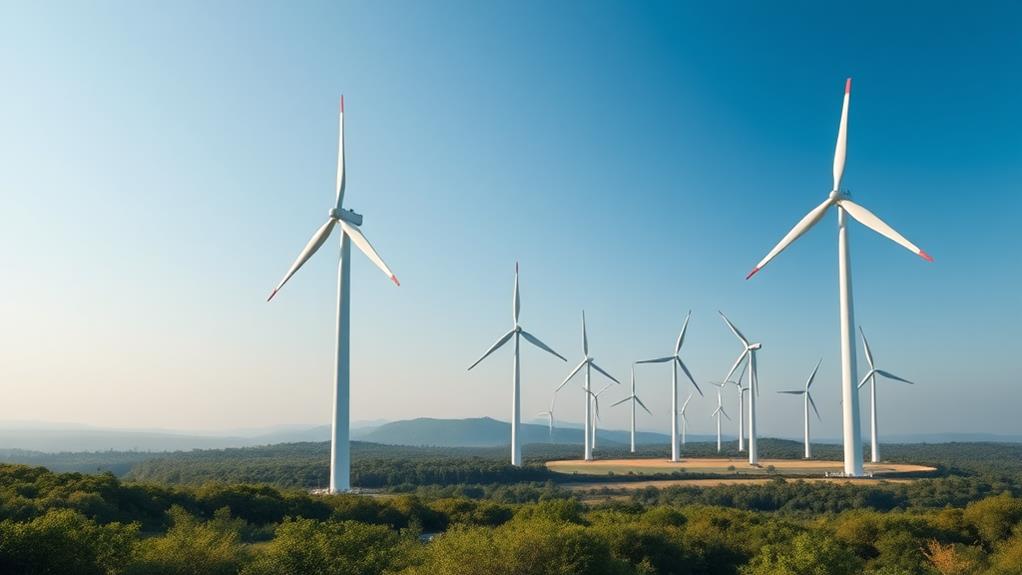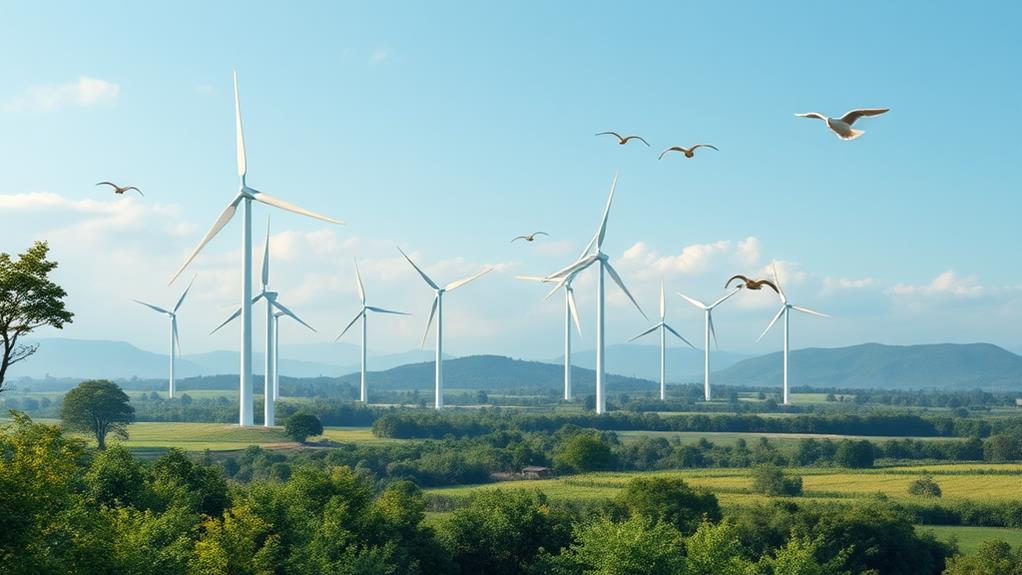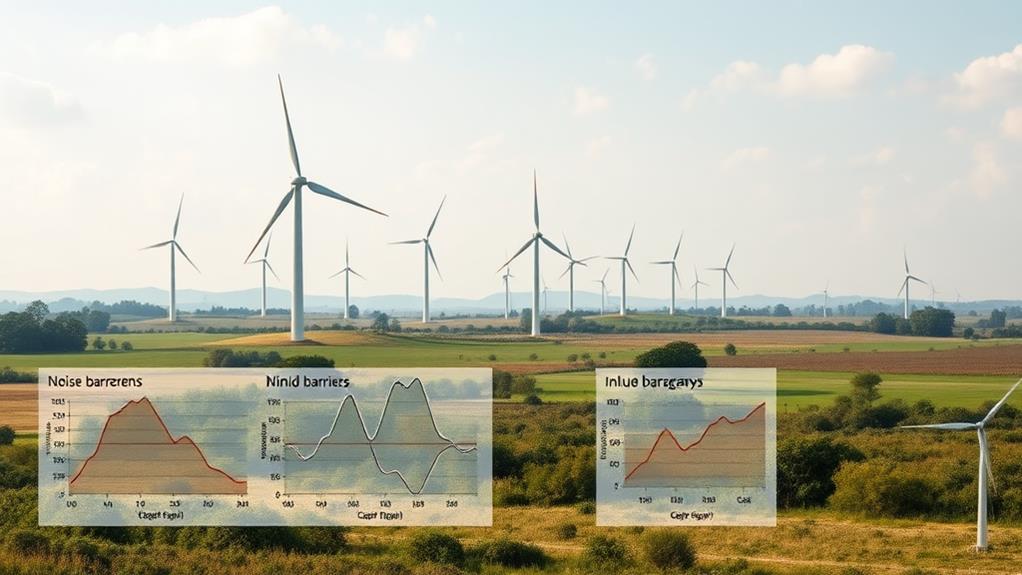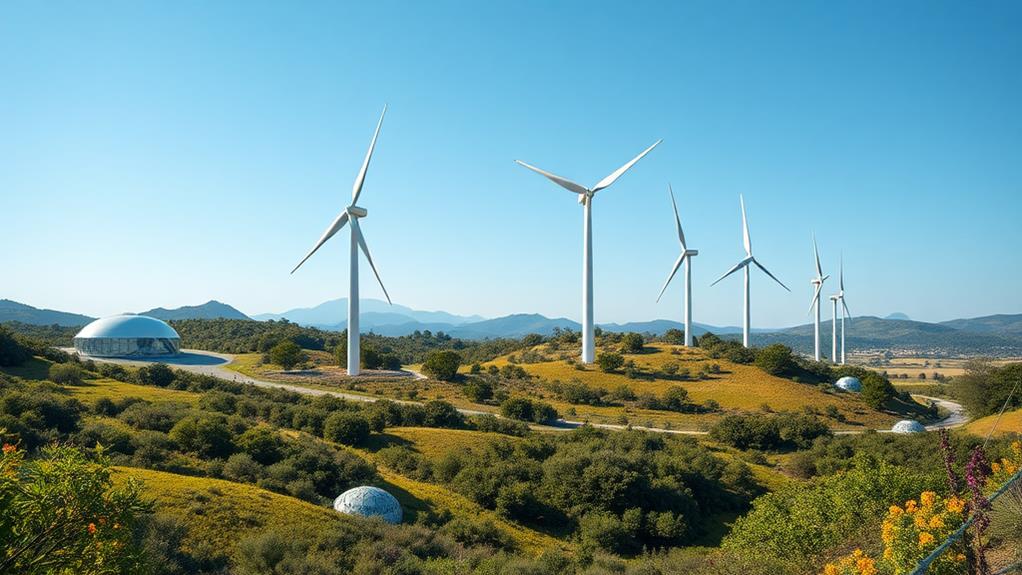To effectively reduce wind farm noise, we must focus on several key techniques, including strategic site selection, which maintains a minimum distance from sensitive receptors, and low-noise turbine designs that utilize aerodynamic blade shapes and variable speed control to minimize emissions. Implementing advanced sound insulation methods, such as acoustic barriers and double-walled enclosures, can substantially mitigate noise levels, potentially reducing them by up to 20 dBA. Additionally, developing a thorough noise management plan guarantees compliance with regulations, while community engagement practices foster transparency and acceptance. By exploring innovations, we can improve upon these techniques and enhance overall effectiveness.
Key Takeaways
- Maintain a distance of at least 500 meters from sensitive areas during site selection to minimize noise impact.
- Implement low-noise turbine designs with aerodynamic blades and variable speed control to reduce sound emissions.
- Install acoustic barriers using advanced sound-absorbing materials to effectively mitigate wind farm noise.
- Utilize double-walled enclosures and acoustic panels to minimize sound transmission from equipment and substations.
- Develop comprehensive noise management plans that include thorough assessments and specific noise limits to ensure compliance.



Importance of Noise Reduction
Reducing noise from wind farms is essential for maintaining community support and ensuring public health. Noise pollution stemming from these facilities can lead to public resistance, resulting in health issues like headaches and nausea. Effective noise reduction strategies are important; sound emissions from substations can reach up to 80 dBA, surpassing acceptable thresholds that disturb nearby residents. By implementing advanced noise control systems, such as sound-absorptive barriers, we can help comply with local regulations, minimizing fines and operational disruptions. Additionally, engaging with communities about our noise management measures fosters trust and understanding, which is crucial for promoting wind energy’s benefits. Ultimately, addressing noise concerns is significant for the successful integration of renewable energy into our energy mix.
Site Selection Strategies

When choosing a site for a wind farm, we must prioritize locations that minimize noise impact on nearby communities. Effective site selection strategies involve maintaining a minimum distance of 500 meters from sensitive receptors, such as residential areas, schools, and hospitals, to reduce noise generated by turbines. Additionally, we should avoid terrain features like hills and valleys, which can amplify or reflect sound.
| Key Considerations | Details |
|---|---|
| Distance from Sensitive Areas | Minimum 500 meters |
| Terrain Features to Avoid | Hills, valleys, cliffs, water bodies |
| Regulatory Compliance | Local noise level regulations |
Low-Noise Turbine Designs

Selecting the right site for a wind farm lays the groundwork for minimizing noise impact, but equally important are the turbine designs we choose. Low-noise turbine designs, characterized by aerodynamic blade shapes, greatly reduce airflow turbulence, thereby lowering overall noise emissions during operation. Utilizing variable speed control, these wind turbines can adjust their blade rotation according to prevailing wind conditions, optimizing performance while diminishing sound levels. Additionally, turbines with a lower tip speed ratio minimize blade tip noise, enhancing the quiet operation of the facility. Ongoing research continues to innovate in this area, focusing on advanced blade designs and incorporating noise-dampening materials, ensuring that we push the boundaries of low-noise performance in wind energy technology.
Sound Insulation Techniques

As we explore sound insulation techniques for wind farms, it’s essential to take into account various strategies, such as the installation of acoustic barriers and the use of sound-absorbing materials. By enclosing key equipment, including gearboxes and generators, we can greatly reduce mechanical noise, achieving reductions of up to 10 dBA in sound levels. Additionally, applying sound insulation wraps on turbine blades will help mitigate airflow noise, ensuring that we create a quieter environment for surrounding communities.






Acoustic Barrier Installation
Acoustic barriers play an essential role in mitigating wind farm noise, ensuring communities remain undisturbed by the sounds of operation. These noise barriers effectively reduce noise pollution from wind farm substations by creating a separation between the noise sources and surrounding areas. To maximize their effectiveness, we must consider factors like height, density, and strategic placement, which help block direct sound paths and minimize transmission. Utilizing advanced sound-absorbing materials enhances their capability to trap and diffuse noise across various frequencies. In addition, custom designs tailored to specific noise profiles and dimensions of equipment are vital. By implementing these barriers correctly, we can achieve regulatory compliance, thereby reducing disruptions to both urban and rural residents while fostering a more harmonious coexistence with wind energy.
Sound-Absorbing Materials
Utilizing sound-absorbing materials is vital for effectively reducing noise from wind farm operations. These materials are engineered to trap, break down, and diffuse sound, providing significant reductions in noise transmission from substations. Unlike traditional reflective barriers, advanced noise-canceling materials excel by preventing sound amplification and focusing on absorption across various frequencies, which is essential for adhering to noise limits. Implementing customizable sound-absorbing barriers allows us to tailor solutions to specific facility layouts and equipment dimensions, enhancing overall noise control. Additionally, their remarkable durability guarantees they withstand outdoor conditions, maintaining effectiveness over time. By integrating sound-absorbing materials into our wind farm designs, we can achieve a more harmonious balance between energy production and environmental tranquility.
Equipment Enclosure Strategies
When it comes to reducing noise from wind farm substations, we can’t overlook the effectiveness of equipment enclosures. These enclosures utilize sound-insulating materials that effectively absorb and block sound transmission, making them crucial in our renewable energy initiatives. Implementing double-walled enclosures with sound-absorbing infill can reduce noise levels by up to 20 dBA, helping us comply with local noise regulations. Additionally, incorporating acoustic panels enhances our noise reduction efforts, targeting both high and low-frequency sound waves.
Here’s a quick overview of key strategies:
| Strategy | Description |
|---|---|
| Double-walled enclosures | Reduces noise by up to 20 dBA |
| Acoustic panels | Targets high and low-frequency sound waves |
| Sealing gaps | Maintains insulation and prevents overheating |
| Proper ventilation | Guarantees airflow while minimizing noise |
| Regular maintenance | Preserves integrity and effectiveness of insulation |
Variable Speed Control

In exploring the advantages of variable speed control in wind turbines, we recognize its capacity to adapt blade rotation according to varying wind speeds, which not only optimizes energy capture but also considerably minimizes noise levels. By adjusting rotor speed in response to actual wind conditions, we can achieve a reduction in aerodynamic and mechanical noise, with studies indicating a decrease of up to 10 dBA compared to traditional fixed-speed systems. However, while the implementation of this technology enhances operational efficiency and component lifespan, we must also consider the challenges involved in integrating variable speed systems into existing turbine designs.
Advantages of Variable Speed
There’s a clear advantage to using variable speed control in wind turbines: it allows for a smarter response to varying wind conditions. This technology not only optimizes energy capture but also minimizes noise, addressing concerns from local communities effectively. Here are three key benefits of variable speed systems:
- Enhanced Efficiency: Variable speed control can improve wind power capacity by up to 10% in fluctuating conditions.
- Noise Reduction: By adjusting rotor speed during lower wind conditions, we can considerably decrease tip speed noise, leading to quieter operation.
- Durability: Maintaining a lower blade angle during high winds reduces aerodynamic noise and prevents excessive wear on turbine components.
Implementation Challenges
While variable speed control offers significant benefits, its implementation comes with notable challenges that we must navigate. The technical intricacies of calibrating turbine systems for ideal performance across diverse wind conditions can be intimidating. Additionally, retrofitting existing turbines involves substantial investment and potential downtime, which could hinder our overall energy production and wind capacity. The turbine’s design and the specific algorithms used for speed adjustments also influence the effectiveness of variable speed control. Ensuring reliability and safety necessitates rigorous testing and validation, complicating the integration process. Finally, thorough operator training is essential; understanding the dynamics of wind behavior and turbine response is vital to optimize our operations and fully leverage the advantages of variable speed technology.
Impact on Noise Levels
Variable speed control can make a significant impact on noise levels generated by wind turbines. By adapting to changing wind conditions, this technology plays a vital role in reducing wind farm noise. Here are three key benefits of variable speed control:
- It minimizes blade tip speed during low wind scenarios, thereby decreasing aerodynamic noise.
- It allows for optimized blade pitch, which further reduces noise emissions across varying wind speeds.
- Studies indicate that implementing this technology can lower overall noise levels by up to 10 dBA, enhancing community acceptance.
Moreover, variable speed control not only lessens noise levels but also boosts energy efficiency and prolongs turbine lifespan by reducing mechanical stress. This multifaceted approach presents a compelling case for its adoption in wind energy projects.
Noise Management Plans

Creating an effective noise management plan is fundamental for minimizing the impact of wind farm operations on surrounding communities. Our extensive noise management plans should begin with a thorough noise assessment to predict potential Wind Energy Noise impacts, identifying sensitive receptors and establishing mitigation strategies. By setting specific noise limits, we guarantee compliance with local regulations, which minimizes disturbances and fosters better community relations. Regular noise monitoring is essential for tracking actual levels, allowing us to make timely operational adjustments. Additionally, we must incorporate a structured response process for addressing public noise complaints, making sure concerns are acknowledged. Engaging stakeholders—including local communities, regulators, and environmental groups—is critical for developing trust and transparency regarding wind farm noise impacts.
Community Engagement Practices

Community engagement is essential for the success of wind farm projects, especially when it comes to addressing noise concerns. By actively involving local communities, we can foster trust and understanding about wind farm operations and their impact on noise levels. Here are three effective practices:
- Consultations and Workshops: These gatherings allow us to directly hear community feedback and adjust our noise management strategies accordingly.
- Regular Updates: Sharing information through newsletters and social media keeps stakeholders informed and engaged in the development process.
- Collaborative Discussions: Involving regulators, developers, and environmental groups guarantees a holistic approach to noise management, addressing diverse concerns.
Future Innovations in Noise Control

As we look ahead, the field of wind farm noise control is gearing up for exciting advancements that promise to greatly reduce sound emissions. Research into advanced noise-canceling materials is evolving, with some recent developments improving sound absorption by over 25% compared to traditional options. Innovations in turbine blade design, particularly serrated edges, have demonstrated a reduction in aerodynamic noise by up to 10 decibels. Additionally, the integration of machine learning algorithms for real-time noise monitoring will enhance operational efficiency while addressing potential health problems related to noise exposure. Active noise control systems, which generate opposing sound waves, and variable speed drive systems adjusting blade rotation based on wind conditions, are also promising innovations for the future of renewable power generation.
Frequently Asked Questions
How Can We Make Wind Turbines Less Noisy?
When we think about making wind turbines less noisy, we can focus on innovative turbine design and acoustic materials. By embracing these advancements, we can enjoy cleaner energy without compromising the tranquility of our surroundings.
What Technology Is Used to Reduce Noise Generated by Turbine Blades?
We’ve seen that innovative blade design minimizes noise by optimizing airflow. Additionally, noise barriers can be implemented around turbines, creating a harmonious balance between harnessing wind energy and maintaining the freedom of a quieter environment.
How Do I Reduce Wind Noise in Audio?
Like a sail catching the breeze, we can harness our audio by employing wind soundproofing techniques. Let’s embrace audio editing tools, use directional mics, and record in calm settings for clearer, more liberated sound.
Why Are Wind Turbines so Noisy?
We often wonder why wind turbines are so noisy. It’s largely due to turbine design and how sound perception varies among individuals. The interaction of blades with air creates noise that can affect nearby communities.









